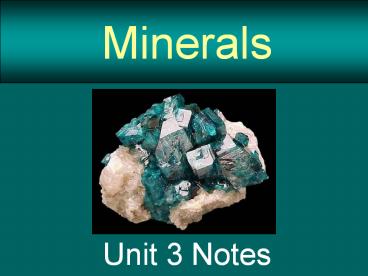Minerals - PowerPoint PPT Presentation
Title: Minerals
1
Minerals
- Unit 3 Notes
2
What is a mineral?
- A mineral must be all of the following
- Naturally occurring
- Inorganic solid (not living)
- Definite structure
- Definite composition (what its made of)
3
What is a crystal?
- A crystal is a solid in which the atoms are
arranged in repeating patterns
4
Crystal Structure
- Here are the six crystal systems that all
minerals belong to - Cubic sylvite, halite
- Hexagonal emerald, graphite
- Tetragonal wulfenite, zircon
- Orthorhombic topaz, sulfur
- Monoclinic gypsum, mica
- Triclinic kyanite, turquoise
5
Elements in Earths Crust
6
Name Symbol By Mass
Oxygen O 46.6
Silicon Si 27.7
Aluminum Al 8.1
Iron Fe 5.0
Calcium Ca 3.6
Sodium Na 2.8
Potassium K 2.6
Magnesium Mg 2.1
Others ---- 1.5
7
Mineral Composition
- Silicates (Si O)
- Carbonates (C O)
8
Silicates
The silica tetrahedron consists of four oxygen
atoms packed closely around a single silicon
atom. Named for its shape (like a 3D pyramid).
9
How do minerals form?
- 3 Ways
- Cooling of molten rock (lava or magma)
- Evaporation of liquid
- Saturated solutions
10
Mineral Crystal Size
- Small Crystals indicates slow cooling of molten
rock - Large Crystals indicates fast cooling of molten
rock
11
Mineral Identification
- Color color is the first property you notice
this is usually the 1st step in identification,
but the least useful
12
Quartz and Fluorite come in many different
colors
13
Mineral Identification
- Hardness is a minerals resistance to being
scratched
14
Mohs Scale of Hardness
- Scale ranges from 1 to 10
- 1 is softest 10 is hardest
15
Factoid
- What is the hardest substance on Earth??
- A diamond is the hardest substance
- (10 on Mohs scale)
16
Mohs Hardness Scale
10 Diamond
9 Corundum
8 Topaz
7 Quartz
6 Feldspar
5 Apatite
4 Fluorite
3 Calcite
2 Gypsum
1 Talc
17
Mineral Identification
- Streak the color of the powder left when a
mineral is rubbed against a hard rough surface
(usually unglazed porcelain)
18
Testing Mineral Specimens
19
Mineral Identification
- Luster the way light reflects from a minerals
surface
20
2 Types of Luster
- Metallic shiny
- Nonmetallic glassy, brilliant, greasy, oily,
waxy, silky, or pearly
21
Metallic Luster
Pearly Luster (Non-Metallic)
Vitreous Luster (Non-Metallic)
22
Mineral Identification
- Cleavage mineral breaks along smooth surface
- Fracture mineral breaks unevenly (jagged)
23
Mineral Identification
- Specific Gravity comparing density of a mineral
to the density of water
24
Mineral Identification
- Acid Test some minerals give off CO2 (carbon
dioxide) when acid is added.
25
If its a carbonate
26
Mineral Usage
- Ore mineral resource mined for a profit
- Gem mineral that is beautiful, rare, and
valuable
27
Metals
- Metals are elements that have metallic luster,
malleability, ductility, and conductivity
28
Malleability
- the ability of a mineral to be hammered without
breaking
29
Ductility
- the ability to be pulled and stretched without
breaking
30
Conductivity
- the ability to conduct heat or electricity

